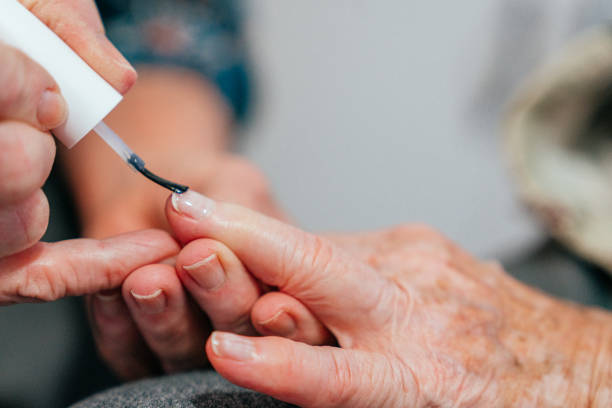In-home nail care for seniors, Aging brings a host of changes to the body, affecting everything from joint mobility to skin texture. One area that often requires extra attention is nail and foot care. For seniors, maintaining good nail health can be challenging but is essential for preventing infections, discomfort, and improving overall quality of life. In-home nail care for seniors is an invaluable solution, providing the necessary care and attention without the hassle of traveling to a salon or clinic. This article delves into the reasons why foot care for seniors is crucial, explores best practices for nail and foot maintenance at home, and answers key questions about how to ensure safety, comfort, and effectiveness in home-based care.

As people age, the natural process of cell renewal slows down. This often causes nails to become brittle, thick, and more susceptible to conditions like fungus and ingrown nails. Furthermore, seniors may face physical limitations due to decreased mobility, arthritis, or poor eyesight, which make it hard to bend, reach, and properly trim their nails. This is where in-home nail care for seniors becomes invaluable. By receiving nail care in the comfort of their homes, seniors avoid unnecessary stress and the risks associated with external environments, such as falls or transportation issues.
Additionally, in-home nail care professionals are often trained to meet the unique needs of elderly clients. They can manage age-related challenges, such as thickened nails, fragile skin, or circulatory issues that complicate routine nail care. These professionals also understand the precautions necessary to prevent infections, especially for seniors with diabetes or compromised immune systems. In-home nail care isn’t merely a convenience—it’s a necessary adaptation that promotes safety and dignity in senior nail care.

There are numerous benefits to in-home nail care for seniors, ranging from health improvements to enhanced comfort and convenience. Here’s a closer look at these advantages:
Traveling to a clinic or salon can be exhausting and challenging for many seniors. In-home services eliminate the need for transportation, reducing stress and making it easier to maintain a consistent care routine.
When a professional comes to a senior’s home, they can provide a more personalized experience. Seniors can sit in their favorite chair, enjoy a familiar environment, and feel at ease. Professionals are often able to provide customized care suited to the unique needs of the elderly, including gentle touch and special handling for delicate skin.
Proper nail and foot care reduce the risk of infection, which is crucial for seniors, especially those with underlying health issues. In-home care specialists are trained to work with aging skin and thickened nails, reducing the chances of cuts, infections, or other complications.
Regular foot care for seniors contributes significantly to improved mobility. Thick or overgrown toenails can cause pain while walking, and neglecting nail care can lead to infections that make movement even more uncomfortable. Healthy nails and feet promote comfort and reduce pain, helping seniors stay active and independent.


While in-home nail care focuses on maintaining healthy nails, foot care for seniors is equally important for overall health and mobility. Here’s how seniors and caregivers can ensure proper foot care at home:
Keeping feet clean and moisturized is one of the simplest yet most effective practices. Use warm water and a mild soap to clean feet, then apply a gentle moisturizer to prevent cracked heels and dryness. However, avoid applying lotion between the toes, as this can create a moist environment that may encourage fungal growth.
Footwear plays a critical role in foot health. Seniors should choose shoes that provide ample support, fit well, and accommodate any foot conditions. Shoes that are too tight can cause blisters or restrict circulation, while overly loose shoes increase the risk of falls. Orthopedic shoes or inserts are excellent options for additional support.
Simple exercises like ankle rotations, calf stretches, and foot rolls improve circulation and prevent stiffness. Regular movement helps keep joints flexible and reduces swelling, making it easier to maintain good foot health.
Many seniors experience reduced circulation in their feet, which can lead to numbness, swelling, or cold feet. To encourage healthy blood flow, seniors can elevate their feet when resting, avoid sitting for prolonged periods, and gently massage their feet to improve circulation.
Diabetic seniors need to be particularly careful with their feet, as even minor cuts or blisters can lead to serious infections. Daily foot inspections, gentle washing, and moisturizing are essential. Diabetic foot care specialists can provide additional support and treatment options if needed.
The frequency of in-home nail care for seniors depends on individual needs and health conditions. Generally, a routine of nail care every 4-6 weeks is sufficient for most seniors. However, those with conditions like diabetes, thick nails, or circulation issues may benefit from more frequent care. Regular appointments help keep nails at a manageable length, ensure early detection of issues, and maintain overall foot health.

Yes, in-home nail care is designed with the safety and comfort of seniors in mind. Professionals who specialize in senior care understand the unique challenges posed by conditions like arthritis, poor circulation, or diabetes. They use gentle techniques and tools that reduce the risk of cuts and infections. Moreover, they are equipped to identify any issues that may require medical attention and can advise on follow-up care if needed.
In-home nail care professionals take every precaution to create a safe, hygienic environment by sanitizing tools, using protective gloves, and being mindful of seniors’ physical limitations. By bringing care directly to the home, seniors avoid the risk of infections from public facilities and gain the peace of mind that comes from receiving personalized, focused attention.
In-home nail care for seniors is a valuable service that significantly enhances quality of life by prioritizing health, comfort, and convenience. Alongside regular foot care for seniors, it promotes independence, mobility, and well-being, allowing seniors to stay active, comfortable, and confident. Whether performed by family members, caregivers, or professional service providers, these practices offer long-term benefits that help seniors maintain good health and enjoy their golden years to the fullest.